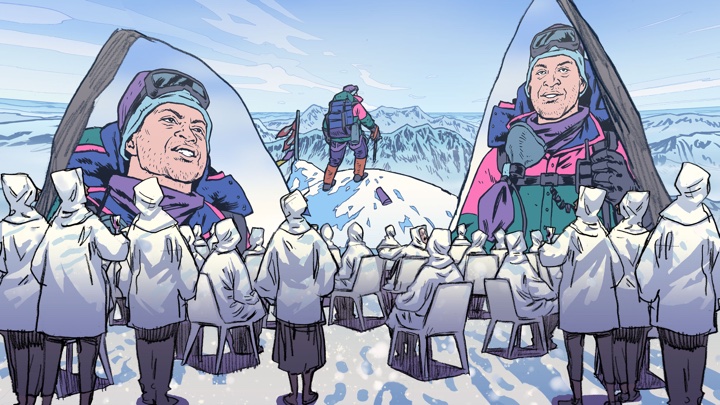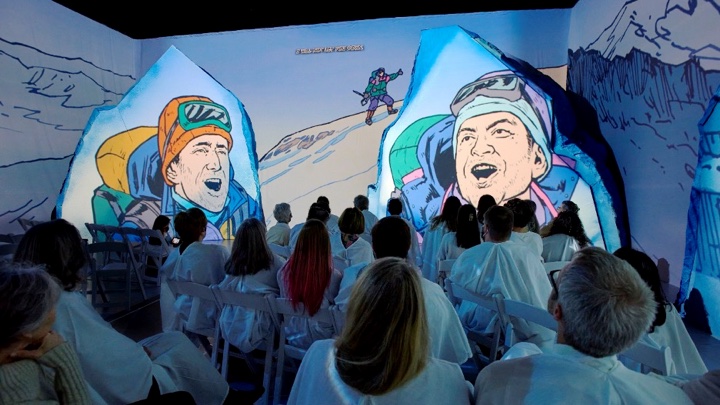

Similarly, many of the online content creation websites are now peppered with videos specifically designed to trigger ASMR (autonomous sensory meridian response)—a tingling positive sensation on the skin.
In the theater world, immersive productions have been well established (witness the long-running Sleep No More, for example) and recently, they seem to be gaining popularity for musicals, both old and new. Cabaret is currently a big hit in West End, and two more immersive productions are gracing either side of Atlantic soon: Guys and Dolls coming next month there, and Here Lies Love hanging its disco ball on Broadway in the summer.
Now the opera world can have a taste of what an immersive opera looks like, as Opera Parallèle opened their spectacular world premiere of Everest: An Immersive Experience on Friday February 4 at Z Space. OP, who is now entering their second decade of producing operas, stays true to their mission to “merge tradition with innovation to re-invent opera for our modern world,” so no surprise that they put together such an astonishing labor of love, full of exquisite intricacies and glorious technical innovations.
But before I continue further, please allow me to be extremely clear of what Everest: An Immersive Experience constitutes; it is a fully-immersive graphic novel opera production with recorded sound—without any singers, chorus, or orchestra around!
Everest (the opera) was the first opera of composer Joby Talbot, working closely with librettist Gene Scheer, and set in one act. Everest was based on the real-life event “1996 Mount Everest disaster,” when eight climbers caught in a blizzard on Mount Everest on May 10-11, 1996 and passed away while attempted to descend from the summit.
The event was additionally the source of 1998 IMAX documentary film Everest, as well as the 2015 feature film Everest, starring Jason Clarke and Jake Gyllenhaal. The opera, however, focused on three people specifically, the expedition leader Rob Hall and two of his clients, Doug Hansen and Beck Weathers (the only survivor in the opera) … plus Rob’s pregnant wife Jan Arnold and Beck’s daughter Meg.
Historically, Everest had its world premiere on January 30, 2015 at Dallas Opera with Sasha Cooke originating the role of Jan Arnold, Andrew Bidlack Rob Hall, Craig Verm Doug Hansen, Kevin Burdette Beck Weathers and Julia Rose Arduino Meg Weathers. OP’s General and Artistic Director Nicole Paiement conducted the production by Leonard Foglia, which then traveled to Kansas City Lyric Opera and Opera Calgary.
During the pandemic, OP remounted the opera as Everest—A Graphic Novel Opera, a digital graphic novel directed by OP’s Creative Director Brian Staufenbiel, with illustrations by Mark Simmons and David Murakami acted as Director of Photography. Graphic novel wasn’t a new thing for OP, having dealt with it in 2013 Gesualdo, Prince of Madness (https://operaparallele.org/opera-parallele-graphicopera-project/ ) before.
Everest—A Graphic Novel Opera was available for streaming through Dallas Opera’s digital video streaming site thedallasopera.TV till January last year. This time, Nathan Granner assumed the role of Rob Hall, Hadleigh Adams Doug Hansen and Charlotte Fanvu as Meg Weathers, while Cooke and Burdette reprising their original roles. The critical success of that graphic novel prompted OP to take one step further and presented it as an immersive experience.
Everest—A Graphic Novel Opera was more than just an illustrated digital video. OP used a motion-capture technology (think of James Cameron’s popular Avatar) to realize the singers’ facial expressions on the digital canvas in order to be animated. In the post-production talk last Friday, Simmons illustrated the difficulties of keeping the singers staying put in one direction and only emoting the words with their face. Nevertheless, Simmons and Murakami successfully captured the nuances of the emotions from each character, and they were certainly a great asset moving into the immersive experience.
I was initially quite concerned that this would end up feeling like an animatronic ride in Disneyland, but my fears subsided the moment I entered the performance space of Z Space. Scenic designer Jacquelyn Scott transformed the space into Mount Everest base camp, with three large ice “boulders” acting as the projection space for the action to happen.
Scott put white screens on all 4 directions, upon which the nine projectors working continuously throughout to move to storyline, and at no point in time those screens were empty. Additionally, sound engineer Miles Lassi imbued the space with static noises and occasionally crackling radio voices, representing the emptiness and the vastness of space that awaited the audience!
For these performances, the audience was encouraged to wear whites or otherwise was given white ponchos to wear over the clothes—it was a truly smart move (after all, we were all just specks of snow!) since the audience was just reflecting the predominantly blue lightings on the space, almost as if they were just tiny peaks of Everest!
One of the strongest points of the opera (the one that easily enabled its transition to immersive production) was Talbot’s evocative soundscape, and Lassi painstakingly distilled the recording into three-dimensional musical topography, where the sound engulfed the audience from all sorts of directions, not unlike the audio object technology employed by the excellent Dolby Cinema.
Mind you, OP didn’t just record the orchestra and blasted it through the speaker; in the video below Paiement detailed how she worked closely with Talbot to recreate the sound of 60-piece orchestra in MIDI instruments to enable Massi to place them in the perfect spots.
Similarly, instead of a full chorus (to represent the lost souls on Everest), Paiement got a vocal quartet (Matt Boehler, Shawnette Sulker, Whitney Steele and Kevin Gino) and “layered multiple takes of their voices to create a rich choral sound”. The end result was a breathtaking audio landscape that stimulated the brain and attacked the senses (and yes, even triggered ASMR!)
Simmons’ illustrations for the graphic novel were marvelously detailed and intimately nuanced; his work certainly could compete with the best digital graphic novels all around the world. They were vividly rendered on the 360 screens as if they jumped to life. Having the three protagonists blown-up on the screen also gave each of them a larger-than-life persona, and the audience couldn’t help but get drawn into each character’s emotional and physical arch.
I only wished that Simmons employed a different color palette for Doug Hansen and Beck Weathers, as the two of them were rather hard to tell apart. I made the mistake of not reading the synopsis prior to the performance, and initially I (and my opera buddy) thought the whole story was only about Rob and Doug (although I recognized that there were two different voices involved for “Doug”). Only after I got home and read the synopsis, I got more clarity about the roles!
Since all the voices were recorded, it was rather hard to judge the individual singers, especially with some much going on attacking all the senses. Collectively, they performed wondrously together, with Granner and Cooke particularly making a heroic couple, despite tragic circumstances.
Everest: An Immersive Experience was truly a major milestone for OP, and I really wish them to succeed with this production. It is so heartening to see that some of the dates are already sold out! I hope OP may also consider expanding this in the future for an immersive production with real-life singers and orchestra!
Listening to Paiement’s post-performance talk, particularly regarding pushing the boundaries of opera and bringing new audience, I couldn’t help but thinking about my colleague Dawn Fatale’s last month article “Rebranding the Met” (https://parterre.com/2023/01/11/rebranding-the-met/ ). Here is a perfect example of how thinking outside the box while maintaining integrity and quality can help to encourage excitement and counter dwindling audience. After all, just like any other art forms, opera needs to adapt to survive!
In the end, if you’re a fan of Immersive Van Gogh experience or Sleep No More, or even if you just enjoy VR games with Oculus, please give this ambitious project a try, and be ready to be transformed to the wonderful world of selfless love, unbroken bound of friendship and above all, living life to the fullest! Everest: An Immersive Experience is playing daily this whole week till Sunday February 12, and there are a couple performances where mask is required if that is important to you!


























Comments